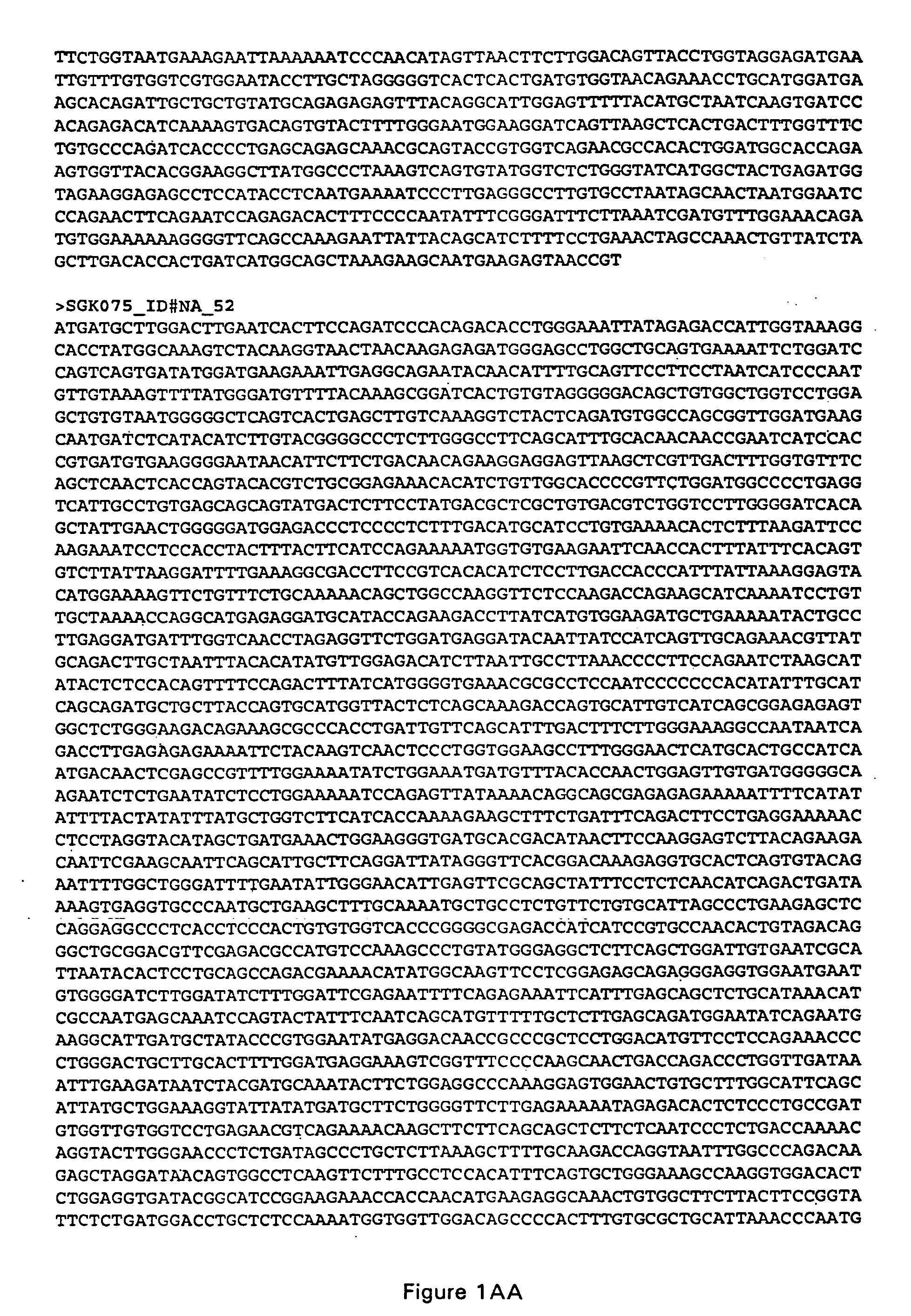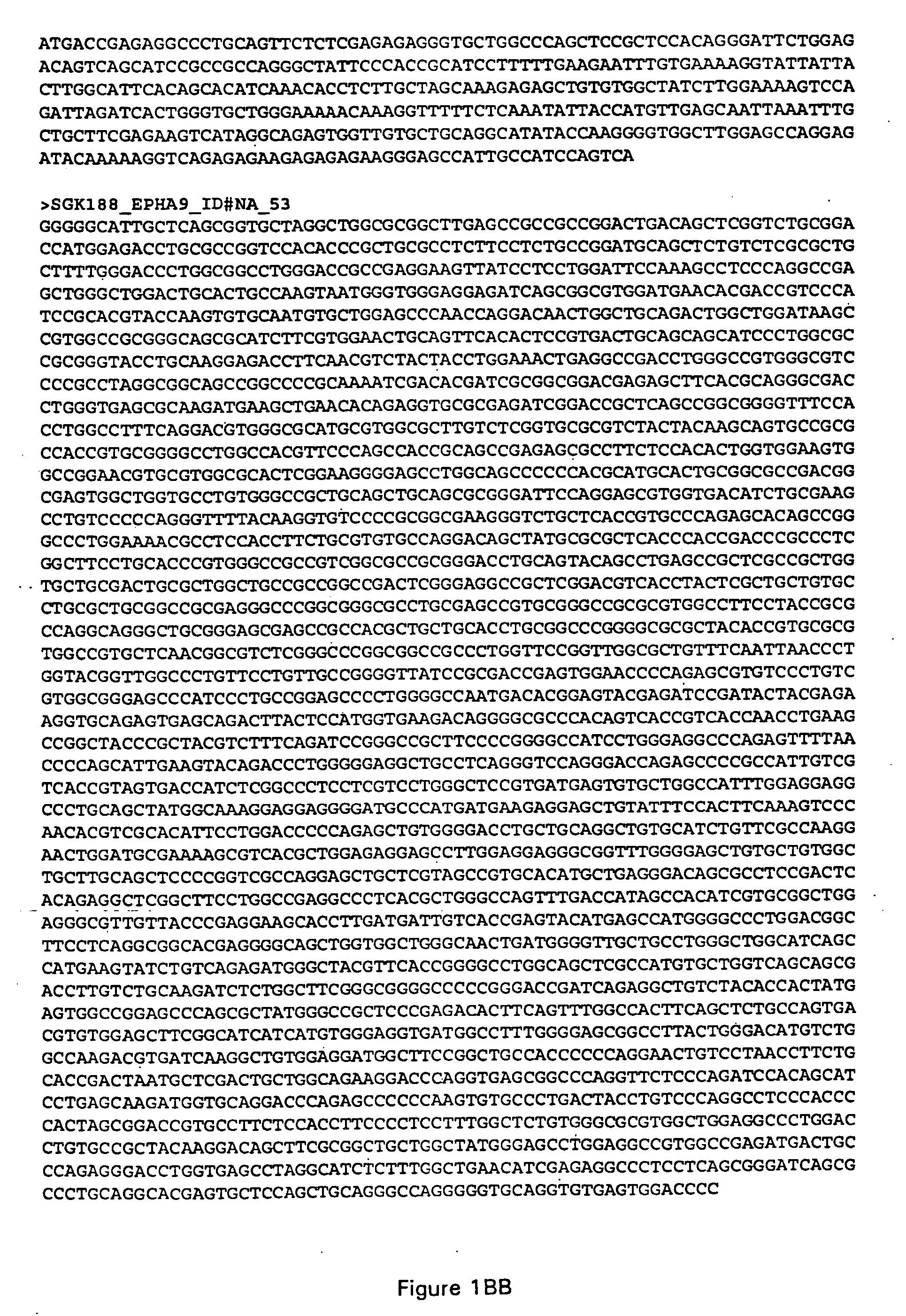Novel human protein kinases and protein kinase-like enzymes
a technology of protein kinase and kinase-like enzymes, which is applied in the field of kinase polypeptides, nucleotide sequences encoding the kinase polypeptides, can solve the problem that mammalian kinases cannot complement the nim phenotype,
- Summary
- Abstract
- Description
- Claims
- Application Information
AI Technical Summary
Benefits of technology
Problems solved by technology
Method used
Image
Examples
example 1
Identification and Characterization of Genomic Fragments Encoding Protein Kinases
[0405] Materials and Methods
[0406] Novel kinases were identified from the Celera human genomic sequence databases, and from the public Human Genome Sequencing project (http: / / www.ncbi.nlm.nih.gov / ) using a hidden Markov model (HMMR) built with 70 mammalian and yeast kinase catalytic domain sequences. These sequences were chosen from a comprehensive collection of kinases such that no two sequences had more than 50% sequence identity. The genomic database entries were translated in six open reading frames and searched against the model using a Timelogic Decypher box with a Field programmable array (FPGA) accelerated version of HMMR2.1. The DNA sequences encoding the predicted protein sequences aligning to the HMMR profile were extracted from the original genomic database. The nucleic acid sequences were then clustered using the Pangea Clustering tool to eliminated repetitive entries. The putative protei...
example 2a
Probe Generation
[0740] Genomic fragments were PCR cloned to be used as probes. Exon fragments were cloned from genomic DNA sources (HUVEC or HMEC) by PCR methodology. Annealing temperature for the oligos used was 68C in a 50 microliter reaction. 5 microliter aliquots were analyzed by agarose gel electrophoresis to verify the correct size fragment was obtained. Fragments of the correct size were excised from the agarose gel and gene-cleaned and subcloned into the pCR-TOPO4 vector (Stratagene). These ligated plasmids were transformed into E. coli bacteria (TOP10 strain / Stratagene) and selected using ampicillin antibiotic resistance. Resulting colonies, four per construct, were grown in media containing ampicillin and the plasmid DNA purified. Restriction digest analysis was carried out to verify the correct DNA insert. Plasmids containing fragments of the correct size were sequence verified using the T7 and T3 primers. DNA fragments to be used as probes for the blots were generated ...
example 2b
Expression Analysis of Polypeptides of the Invention
[0741] The gene expression patterns for selected genes were studied using four techniques: 1) a tissue microarray developed at Sugen, containing over 450 tissues and probed with labeled genes; 2) a PCR screen of 48 human tissues (this technique does not yield quantitative expression levels between tissues, but does identify those tissues that express the gene at a level detectable by PCR, as well as those that do not express the gene at such a level), 3) a commercial array of tissue from Clontech, probed with labeled genes, and 4) for one gene (SGKO93), an analysis form Northern blotting.
[0742]“cDNA libraries” derived from over 450 tissue or cell line sources were immobilized onto nylon membranes and probed with 32P-labeled cDNA fragments derived from the gene(s) of interest. To make the cDNA, total RNA or mRNA was used as template in a reverse transcription reaction to generate single-stranded cDNAs (ss cDNA) t...
PUM
| Property | Measurement | Unit |
|---|---|---|
| Mass | aaaaa | aaaaa |
| Fraction | aaaaa | aaaaa |
| Fraction | aaaaa | aaaaa |
Abstract
Description
Claims
Application Information
 Login to View More
Login to View More - R&D
- Intellectual Property
- Life Sciences
- Materials
- Tech Scout
- Unparalleled Data Quality
- Higher Quality Content
- 60% Fewer Hallucinations
Browse by: Latest US Patents, China's latest patents, Technical Efficacy Thesaurus, Application Domain, Technology Topic, Popular Technical Reports.
© 2025 PatSnap. All rights reserved.Legal|Privacy policy|Modern Slavery Act Transparency Statement|Sitemap|About US| Contact US: help@patsnap.com



